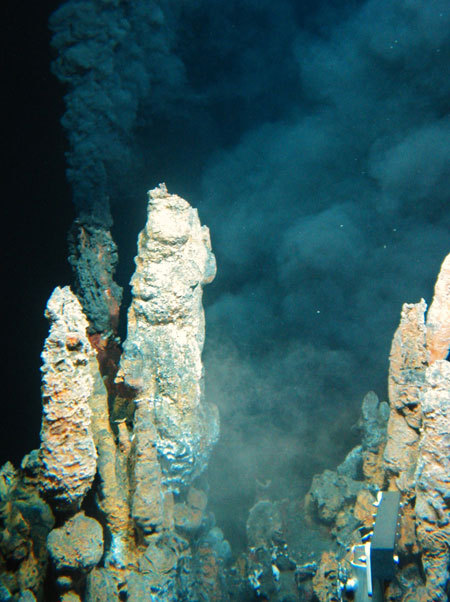
A new theory proposes the primordial life-forms that gave rise to all life on Earth left deep-sea vents because of their "invention" of a tiny pump. These primitive cellular pumps would have powered life-giving chemical reactions.
The idea, detailed Dec. 20 in the journal Cell, could help explain two mysteries of life's early origin: How did the earliest proto-cells power chemical reactions to make the organic building blocks of life; and how did they leave hydrothermal vents to colonize early Earth's oceans?
Authors of the new theory argue the environmental conditions in porous hydrothermal vents — where heated, mineral-laden seawater spews from cracks in the ocean crust — created a gradient in positively charged protons that served as a "battery" to fuel the creation of organic molecules and proto-cells.
Later, primitive cellular pumps gradually evolved the ability to use a different type of gradient — the difference in sodium particles inside and outside the cell — as a battery to power the construction of complex molecules like proteins. And, voilà, the proto-cells could leave the deep-sea hydrothermal vents. [Image Gallery: Unique Life at Deep-Sea Vents]
"A coupling of proton gradients and sodium gradients may have played a major role in the origin of life. This is really cool, novel stuff," Jan Amend, a researcher at the University of Southern California, who was not involved in the study, wrote in an email to LiveScience. The study reflects the increasingly popular idea that a simple, everyday source of power, not a rare occurrence like a lightning strike, could have provided the power to initially create life, he said.
Deep-sea start
Many scientists think life got its start around 3.7 billion years ago in deep-sea hydrothermal vents. But figuring out just how complex, carbon-based life formed in that primordial stew has been tricky.
Sign up for the Live Science daily newsletter now
Get the world’s most fascinating discoveries delivered straight to your inbox.
Somehow, the precursors of life harnessed carbon dioxide and hydrogen available in those primitive conditions to create the building blocks of life, such as amino acids and nucleotides (building blocks of DNA). But those chemical reactions require a power source, said study co-author Nick Lane, a researcher at the University College London.
Now, Lane and William Martin, of the Institute of Molecular Evolution at the Heinrich Heine University in Germany, propose that the rocky mineral walls in ocean-floor vents could have provided the means.
The theory goes: At the time of life's origin, the early ocean was acidic and filled with positively charged protons, while the deep-sea vents spewed out bitter alkaline fluid, which is rich in negatively charged hydroxide ions, Lane told LiveScience.
The vents created furrowed rocky, iron- and sulfur-rich walls full of tiny pores that separated the warm alkaline vent fluid from the cooler, acidic seawater. The interface between the two created a natural charge gradient.
"It's a little bit like a battery," Lane told LiveScience.
That battery then powered the chemical transformation of carbon dioxide and hydrogen into simple carbon-based molecules such as amino acids or proteins. Eventually that gradient drove the creation of cellular membranes, complicated proteins and ribonucleic acid (RNA), a molecule similar to DNA.
Leaving the vents
At that point, primitive cells used the thin, serpentine walls of the vent to corral the new carbon-based molecules together into precursors of cells and used the charge gradient in the environment to power the building of more complex organic chemicals.
But in order to leave the vent, primitive cells would have needed some way to carry a power-producing gradient with them — think battery pack. To solve that problem, the team looked at existing archaea bacteria in deep-sea vents.
Those primeval life-forms use a simple type of cellular pump that pushes sodium out of the cell while pulling positively charged protons in. The team proposed that a precursor to that cellular pump evolved in the membranes of the proto-cells.
The membrane started out very leaky, but over time, the membranes would have slowly closed, preventing much larger sodium particles from leaving the cell while smaller protons could still slip through. That enabled the proto-cells to still use the existing power-source in the environment — the charge gradient — while gradually evolving an independent way of getting power.
Eventually, when the pores closed completely, the primitive cells would have had a sodium pump that could power their cellular reactions, enabling more complex life to form. They could then leave their birthplace.
Testing the idea, however, will be tricky, Amend told LiveScience. "Mimicking natural conditions in the lab is a lot more difficult than it sounds."
Follow LiveScience on Twitter @livescience. We're also on Facebook & Google+.

Tia is the managing editor and was previously a senior writer for Live Science. Her work has appeared in Scientific American, Wired.com and other outlets. She holds a master's degree in bioengineering from the University of Washington, a graduate certificate in science writing from UC Santa Cruz and a bachelor's degree in mechanical engineering from the University of Texas at Austin. Tia was part of a team at the Milwaukee Journal Sentinel that published the Empty Cradles series on preterm births, which won multiple awards, including the 2012 Casey Medal for Meritorious Journalism.









